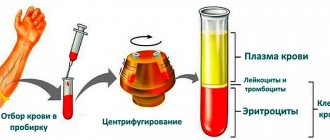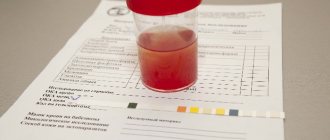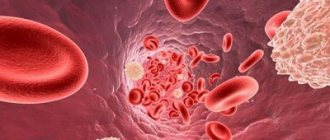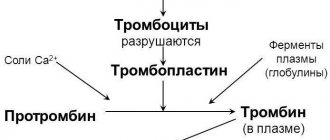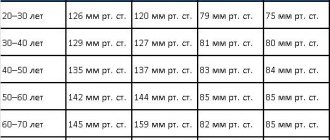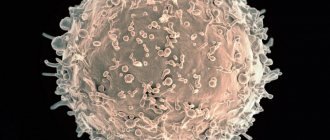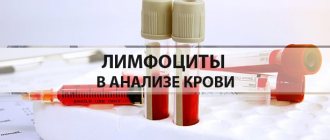The value of normal hematocrit in humans
The body of a healthy adult contains approximately 4.5-5 liters of blood. It contains formed elements and cells - red blood cells, platelets, leukocytes, as well as a liquid part called plasma.
Some blood components, for example, red blood cells, do not have all the necessary components of a human cell, losing them during the maturation process. Therefore, red blood cells and platelets are called blood cells, not cells.
In different categories of patients, the normal values of various parameters of the blood tested will differ. So, for most men, the hematocrit will be higher: 40-41%, and in some cases it can reach up to 51%, which is due to its slower renewal.
In healthy women, the hematocrit usually ranges from 36 to 42%. This is due to physiological features - due to regular menstrual bleeding, blood is renewed more often to replenish its volume. During pregnancy, from the 20th week, the indicator begins to decrease, which is also not considered a deviation.
In children, hematocrit differs at different age periods:
- 44-62% for newborns;
- 32-43% for babies up to three months;
- 36-43% for children under one year of age;
- 35-47% (up to 52% for boys) - in the first ten years.
In subsequent years, the hematocrit norm depends on gender and practically corresponds to the values of an adult.
What should an adult patient do?
Due to increased viscosity, tissues and organs do not receive the necessary nutrients and oxygen. Therefore, it is not recommended to ignore the value of NST when considering the indicators of a general blood test.
Preventive measures primarily include: following a diet, getting rid of nicotine addiction, and increasing the amount of water consumed.
As for diet, the following are excluded from the diet:
- What should be the hematocrit in children?
- Bananas;
- Soda;
- Products containing animal fat;
- Potato.
These products help thicken the blood.
It is recommended to increase the consumption of berries, fruits, vegetables and small amounts of honey.
When the reason lies in pathology, then the doctor prescribes a number of medications to thin the blood, as well as the administration of drugs that are similar to blood plasma.
There are also known folk methods for getting rid of increased NST, such as:
- apple cider vinegar – 2 tablespoons per glass of water in the morning;
- soda – 1 g per glass of boiled water on an empty stomach;
- flaxseed oil – 1 tablespoon on an empty stomach;
- treatment with leeches.
These agents thin the blood, prevent the formation of blood clots, and prevent viscosity.
Important! Traditional medicine has contraindications. When using, consult a doctor.
To prevent an increase in hematocrit, doctors recommend:
- to refuse from bad habits;
- visit areas with thin air and high mountain areas less often;
- increase consumption of fruits and vegetables;
- exercise;
- drink more purified water;
- take a blood test once a year;
- avoid stressful situations.
In conclusion, it is important to note that increased hematocrit is a serious pathology, the consequence of which is undesirable consequences. When this is a consequence of a serious illness, only a consultation with a doctor with further treatment and observation can help.
- Blood test after chemotherapy: normal, interpretation, general blood test
Methods for determining hematocrit
The indicator is determined as a percentage by calculating the amount of formed elements in whole blood. It is calculated using special instruments or manually.
Centrifugation using the Wintrobe method
The blood is exposed to centrifugal force for 10-30 minutes. The formed elements are heavier than plasma, so they settle to the bottom of the test tube. The hematocrit is determined by the ratio of sediment to the total volume of biomaterial.
Calculation of the indicator using the formula
The ratio of the number of red blood cells to the total blood volume can be calculated mathematically. To do this, the following indicators are required:
- total hemoglobin concentration (ctHB);
- red blood cell count (RBC);
- mean erythrocyte volume (MCV);
- mean erythrocyte hemoglobin concentration (MCHC).
The hematocrit number (HCT) is determined by one of the formulas:
- HCT (%)=(ctHB (mmol/l)*0.0485+0.0083)*100
- HCT (%)=0.1*MCV*RBC
- HCT (%)=ctHB/MCHC*100
Direct blood cell counting method
In a given volume of biomaterial, visible blood elements are counted manually or using hematological analyzers. The method is highly accurate, and the measurement process does not take much time - no more than five minutes, but the equipment required is very expensive.
Manual counting method
Blood collected using an anticoagulant is placed in a dry, clean tube and allowed to settle. In this case, the formed elements that have greater weight settle to the bottom of the container, and the light plasma rises to the top, forming two fractions of red and yellow colors, respectively. The hematocrit indicator can be determined by the divisions on the test tube. This method is the least accurate, its error is up to 20%, so it is currently not used in laboratories.
Recommendations
- First of all, you need to control your water and salt balance . To do this, you need to maintain a drinking regime and limit the consumption of coffee, alcohol, melons, watermelons, lingonberries, kefir, and cottage cheese.
- It is recommended to promptly seek medical help to prescribe an examination and appropriate therapy.
- It is not recommended to take coffee and alcohol, as they are diuretics.
- It is necessary to stop smoking and start doing moderate physical activity.
When is a hematocrit test performed?
Most often, hematocrit is determined as part of a general (clinical) blood test. Therefore, at present this parameter of a clinical blood test is not prescribed separately. The hematocrit level changes when:
- disorder of the blood coagulation system;
- dehydration;
- anemia or polycythemia;
- bleeding.
Assessing the hematocrit level is important when determining indications for the need for blood transfusion or the effectiveness of blood transfusion, during hemodialysis, and some operations. To determine the hematocrit number, venous or capillary blood is taken.
Indications and preparation for analysis
The hematocrit indicator is always indicated in the results of a general blood test. This means that it can be assessed:
- During any medical examination or mandatory medical examination.
- In preparation for surgery.
- During hospitalization and before discharge.
But besides this, there are certain indications when it is necessary to determine the hematocrit. In this case, a direct measurement is performed: the plasma is separated by centrifuging the material and an accurate indicator is obtained. Indications for this:
- Bleeding.
- Blood clotting problems
- Dehydration of the body.
- Anemia.
- Polycythemia.
In order to get a reliable result, you should refuse food 6-10 hours before taking blood from a vein or from a finger. As a rule, the analysis is taken in the morning. It is also necessary to avoid drinking alcohol 2-3 days and refrain from smoking 2-3 hours before the procedure.
Increased hematocrit
An increase in hematocrit occurs with an increase in the number of blood cells - polycythemia - and a lack of fluid in the body. An increase in the indicator may indicate serious diseases accompanied by blood thickening and thrombotic complications.
Causes
Hematocrit increases due to stress, taking corticosteroid drugs and diuretics, traumatic shock accompanied by intense pain, as well as when climbing to high altitudes, smoking, or playing sports using anabolic steroids to gain muscle mass.
An increase in the indicator may indicate the following diseases:
- dehydration due to vomiting, profuse diarrhea, overheating or heat stroke, excessive sweating, insufficient fluids;
- heavy bleeding in the midst or immediately after it stops;
- pathologies accompanied by a decrease in blood plasma volume, for example, peritonitis, thrombosis, diabetes, burn disease;
- renal dysfunction - hydronephrosis, oncology, polycystic disease;
- vitamin B12 or iron deficiency anemia;
- leukemia;
- erythrocytosis;
- defects and coronary heart disease, heart failure;
- intestinal obstruction;
- bronchial asthma, pulmonary emphysema, obstructive bronchitis.
Symptoms
An increase in blood viscosity leads to thrombus formation. The latter can manifest itself in the form of tingling or various pains and numbness in the limbs. If the cause of increased blood viscosity is not determined in time, serious complications such as myocardial infarction, stroke, gangrene and even death may develop.
Treatment
Treatment is carried out not for the changed hematocrit level itself, but for the conditions or diseases that caused these changes. In some situations, when serious causes for a slightly changed hematocrit level have been excluded, no treatment is required. But usually such situations are short-lived, in the case of physiological reasons for changes in hematocrit levels.
Reasons for increase not related to diseases
An increase in Ht can be physiological, that is, a deviation from the norm is not related to disease. The body reacts to any changes in order to adapt to new conditions and maintain balance. The reasons for a safe increase in the hematocrit level may be as follows:
- As a result of dehydration, or dehydration. In this case, the amount of circulating blood in the bloodstream decreases due to a decrease in plasma volume. This can happen with vomiting, diarrhea, overheating, heavy sweating, or insufficient fluid intake. In this case, the body is forced to take water from the bloodstream. Thus, the ratio of the volume of the erythrocyte fraction and the total volume changes, the blood becomes thicker due to a decrease in the amount of plasma.
- Hematocrit is higher than normal in newborns. At this age, the norm is 44-62%.
- Hypoxia is chronic. Oxygen deficiency in cells is most often observed in patients with diabetes and smokers. Red blood cells deliver oxygen to tissues and remove carbon dioxide from cells. During hypoxia, the body produces more red blood cells, trying to compensate for the lack of oxygen. A high level of hematocrit and hemoglobin in this case is associated only with an increase in the number of red blood cells, while the total amount of blood in the bloodstream remains unchanged.
- When you stay in the mountains for more than two days, the level of red cells in the blood always increases, and therefore the hematocrit, since at altitude the air is thinner and contains less oxygen. Ht may exceed normal values in peoples living in high mountain areas, but people will not experience any discomfort.
- Elevated Ht levels are typical for athletes using anabolic steroids.
Residents of high mountain areas experience a physiological increase in hematocrit due to chronic hypoxia
Decreased hematocrit
A decreased hematocrit occurs when the number of red blood cells or their size decreases - erythrocytopenia. The cause may also be the accumulation of water in the body when the blood becomes thinner - hyperhydration, as well as hyperproteinemia or the accumulation of proteins in the plasma, which contributes to fluid retention.
Causes
A decrease in hematocrit is facilitated by prolonged immobility, fasting or a strict diet, taking anticoagulants and antiplatelet agents, and intravenous infusions in large volumes; heavy drinking, chronic alcoholism, excessive salt intake, menstruation in women.
Also, a downward change in the indicator may indicate the following pathologies:
- iron-, B12- or folate-deficiency anemia;
- severe bleeding;
- impaired hemoglobin production in sickle cell anemia;
- fibrous degeneration of the liver - cirrhosis;
- disruption of the urinary system;
- hemolysis of erythrocytes - destruction of red blood cells due to hereditary mutation, autoimmune processes or toxic effects on blood cells;
- malaria, typhoid fever;
- oncological diseases of the bone marrow or its metastatic lesions from other organs;
- an increase in the amount of protein in plasma due to vomiting, diarrhea, blood cancer and other conditions.
During pregnancy, a decrease in hematocrit can be observed in the case of toxicosis, a very young age of the mother, multiple pregnancies, a short period of time between pregnancies, and also after the 20th week of gestation due to a physiological increase in fluid in the body.
Symptoms
A decrease in hematocrit in the blood is accompanied by hypoxia of various organs, since it is the red blood cells that normally carry oxygen throughout the body. This condition is manifested by the following symptoms:
- fast fatiguability;
- general weakness;
- drowsiness;
- increased heart rate and breathing;
- feeling of lack of air;
- headache, dizziness;
- decreased memory and concentration;
- hair loss;
- marbling or pallor of the skin.
